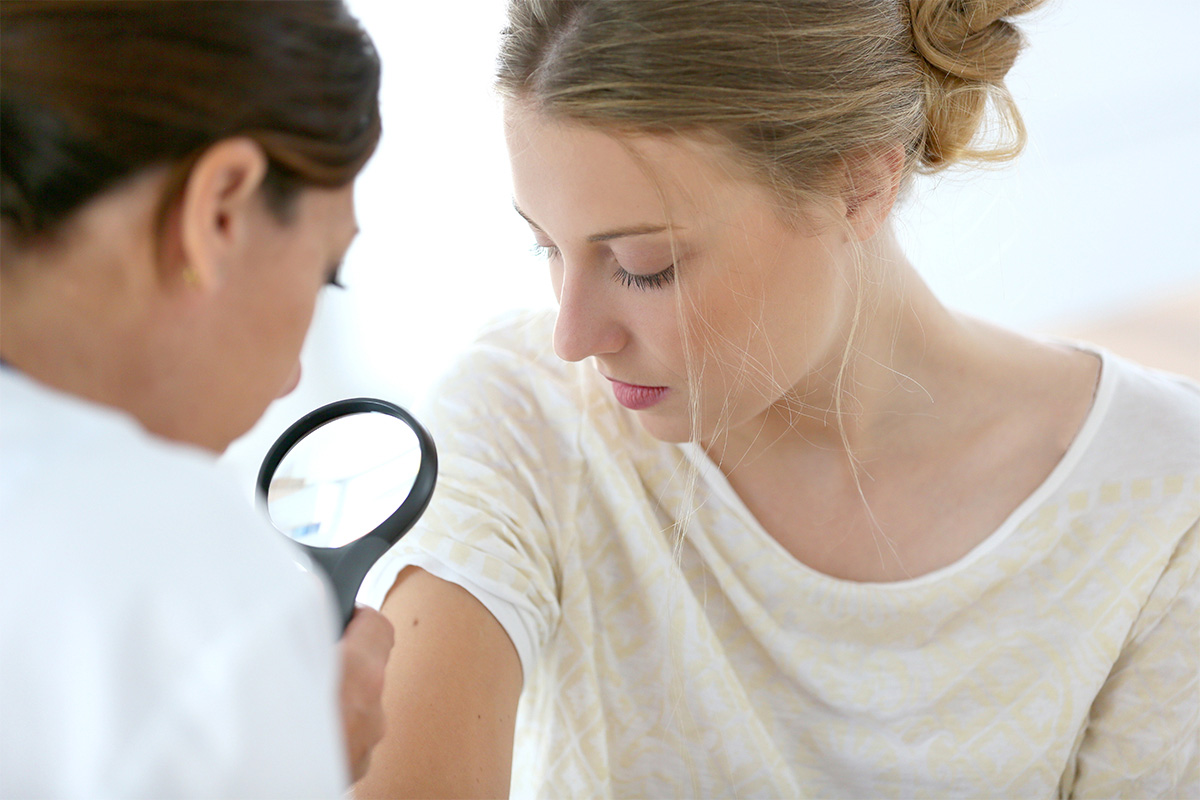
About 1 in 5 Americans will develop skin cancer. Find out the facts about this common disease.
Skin cancer is by far the most common cancer in the United States — close to 10,000 people are diagnosed every day. Despite public health warnings to wear sunscreen, cases of the most dangerous form of skin cancer — melanoma — have been rising rapidly over the last few decades. But the news about skin cancer is not all bad: When treated early, even melanoma has a 5-year survival rate of 94%.
Here’s what you need to know about your chances of getting skin cancer, the different types of skin cancer and what to expect for treatment.
1. Your skin type can influence your risk for skin cancer.
Although anyone can develop skin cancer, some skin types carry a greater risk than others.
“Skin cancer occurs more commonly in people with lighter skin tones, blond or red hair and blue or green eyes,” says Brittney DeClerck, MD, a dermatologist at USC Norris Comprehensive Cancer Center, part of Keck Medicine of USC, and associate professor of clinical pathology and dermatology at the Keck School of Medicine of USC.
She adds that skin that burns more easily than it tans and having a lot of moles will also put a person at a higher risk for skin cancer.
People with skin of color, though, are more likely to be diagnosed later, which contributes to a higher mortality rate for melanoma than for white people. People of color are also more likely to develop skin cancer in areas of the body not exposed to the sun as much, such as the palms of the hands, soles of the feet, groin, inside the mouth and under the nails.
2. Skin cancer runs in families.
Skin cancer has a genetic component.
“Having a family member who has had skin cancer will increase a person’s risk,” Dr. DeClerck says. “People can also inherit genes that can predispose them to developing skin cancer.”
Your personal history of skin cancer, along with your family history, also plays a role.
“Once someone has a single skin cancer, they are at an increased risk for developing additional skin cancers,” Dr. DeClerck explains.
3. Two skin cancer types are more common and less deadly.
There are three common types of skin cancer: basal cell carcinoma, squamous cell carcinoma and melanoma.
Basal cell carcinoma is the most common type of skin cancer.
“It’s also the least deadly,” Dr. DeClerck says.
She explains that basal cell carcinoma typically appears as a shiny pink or red bump on the skin.
This type of skin cancer grows slowly and rarely spreads; however, it can grow deeper into the skin and even affect the bone underneath, if not treated. Basal cell cancer usually appears in places on the body exposed to the sun.
Squamous cell carcinoma is the second most common form of skin cancer.
“Squamous cell carcinoma varies in its risk, based on the location and size of the tumor,” Dr. DeClerck says. “Some squamous cell carcinomas are easily treatable and are not life-threatening; however, others can be quite dangerous.”
She explains that squamous cell carcinomas look similar to basal cell carcinomas and typically present as a pink bump on the skin.
Squamous cell carcinoma appears on areas exposed to the sun but can spread to other areas of the body.
4. Melanoma is the most dangerous form of skin cancer.
Melanoma accounts for about 1% of all skin cancers, but it accounts for the most skin cancer deaths.
“Melanoma is the third most common type of skin cancer and is also the deadliest skin cancer, particularly when it is caught late,” Dr. DeClerck says. “Melanomas most frequently appear as a dark or multicolored spot on the skin.”
“We follow the ABCDE rule when evaluating for melanoma,” she adds.
This means to watch out for moles with these traits:
- A: An asymmetric or irregular shape
- B: Borders that look irregular or poorly defined
- C: Color that varies in shades, which could include brown, black, white, red or even blue
- D: A diameter that is often more than 6 mm, about the size of a pea
- E: Evolving over time, a period of weeks to months
Although it’s less common than basal cell or squamous cell skin cancers, melanoma is more dangerous, because it’s more likely to spread to other parts of the body.
5. There are many skin cancer treatment options.
According to Dr. DeClerck, how your skin cancer is treated depends on several factors, including:
- The type of cancer
- The size of the cancer
- The growth pattern of the cancer
- The location of the cancer
“Once you’re diagnosed, your doctor will go over the options for treatment,” she says. “The options may include topical creams, scrape and burn procedures, surgical excision or Mohs micrographic surgery, which is a specialized surgery that evaluates each layer of the skin to make sure the cancer is completely gone.”
Surgical procedures are usually done in the doctor’s office or clinic with topical numbing medicine. Radiation may also be used for some basal cell or squamous cell cancers.
“For some high-risk skin cancers, such as melanoma and some squamous cell carcinomas, a lymph node biopsy may also be recommended to make sure the cancer hasn’t spread,” Dr. DeClerck says.
In addition to surgery, melanoma treatment might also involve chemotherapy, radiation, immunotherapy or targeted therapy drugs, if necessary.
6. There are everyday things you can do to reduce your risk for skin cancer.
Although some risk factors for skin cancer, like skin type and family history, can’t be controlled, it’s best to follow best practices for the ones you can. This includes:
- Minimizing your exposure to ultraviolet rays, by staying out of the midday sun
- Wearing daily sunscreen with sun protection factor 15 or higher
- Avoiding indoor tanning
Topics
